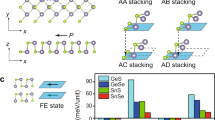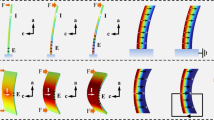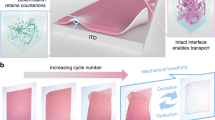Abstract
The direct conversion of mechanical energy into electricity by nanomaterial-based devices offers potential for green energy harvesting1,2,3. A conventional triboelectric nanogenerator converts frictional energy into electricity by producing alternating current (a.c.) triboelectricity. However, this approach is limited by low current density and the need for rectification2. Here, we show that continuous direct-current (d.c.) with a maximum density of 106 A m−2 can be directly generated by a sliding Schottky nanocontact without the application of an external voltage. We demonstrate this by sliding a conductive-atomic force microscope tip on a thin film of molybdenum disulfide (MoS2). Finite element simulation reveals that the anomalously high current density can be attributed to the non-equilibrium carrier transport phenomenon enhanced by the strong local electrical field (105−106 V m−2) at the conductive nanoscale tip4. We hypothesize that the charge transport may be induced by electronic excitation under friction, and the nanoscale current−voltage spectra analysis indicates that the rectifying Schottky barrier at the tip–sample interface plays a critical role in efficient d.c. energy harvesting. This concept is scalable when combined with microfabricated or contact surface modified electrodes, which makes it promising for efficient d.c. triboelectricity generation.
This is a preview of subscription content, access via your institution
Access options
Access Nature and 54 other Nature Portfolio journals
Get Nature+, our best-value online-access subscription
$29.99 / 30 days
cancel any time
Subscribe to this journal
Receive 12 print issues and online access
$259.00 per year
only $21.58 per issue
Buy this article
- Purchase on Springer Link
- Instant access to full article PDF
Prices may be subject to local taxes which are calculated during checkout




Similar content being viewed by others
References
Xu, S. et al. Self-powered nanowire devices. Nat. Nanotech. 5, 366–373 (2010).
Wang, Z. L. Triboelectric nanogenerators as new energy technology for self-powered systems and as active mechanical and chemical sensors. ACS Nano 7, 9533–9557 (2013).
Chen, J. et al. Networks of triboelectric nanogenerators for harvesting water wave energy: a potential approach toward blue energy. ACS Nano 9, 3324–3331 (2015).
Alexe, M. & Hesse, D. Tip-enhanced photovoltaic effects in bismuth ferrite. Nat. Commun. 2, 256 (2011).
Park, J. Y. & Salmeron, M. Fundamental aspects of energy dissipation in friction. Chem. Rev. 114, 677–711 (2013).
Zhu, G. et al. Toward large-scale energy harvesting by a nanoparticle-enhanced triboelectric nanogenerator. Nano Lett. 13, 847–853 (2013).
Zhang, C. et al. Rotating-disk-based direct-current triboelectric nanogenerator. Adv. Energy Mater. 4, 1301798 (2014).
Yang, Y., Zhang, H. & Wang, Z. L. Direct-current triboelectric generator. Adv. Funct. Mater. 24, 3745–3750 (2014).
Wang, X., Song, J., Liu, J. & Wang, Z. L. Direct-current nanogenerator driven by ultrasonic waves. Science 316, 102–105 (2007).
Shao, H., Fang, J., Wang, H., Dai, L. & Lin, T. Polymer–metal Schottky contact with direct‐current outputs. Adv. Mater. 28, 1461–1466 (2016).
Goswami, A. et al. Effect of interface on mid-infrared photothermal response of MoS2 thin film grown by pulsed laser deposition. Nano Res. 10, 1–14 (2016).
Zeng, H., Dai, J., Yao, W., Xiao, D. & Cui, X. Valley polarization in MoS2 monolayers by optical pumping. Nat. Nanotech. 7, 490–493 (2012).
Lopez-Sanchez, O., Lembke, D., Kayci, M., Radenovic, A. & Kis, A. Ultrasensitive photodetectors based on monolayer MoS2. Nat. Nanotech. 8, 497–501 (2013).
Karunadasa, H. I. et al. A molecular MoS2 edge site mimic for catalytic hydrogen generation. Science 335, 698–702 (2012).
Winer, W. Molybdenum disulfide as a lubricant: a review of the fundamental knowledge. Wear 10, 422–452 (1967).
Chhowalla, M. & Amaratunga, G. A. Thin films of fullerene-like MoS2 nanoparticles with ultra-low friction and wear. Nature 407, 164–167 (2000).
Wang, S. et al. Shape evolution of monolayer MoS2 crystals grown by chemical vapor deposition. Chem. Mater. 26, 6371–6379 (2014).
Zhou, Y. S. et al. Manipulating nanoscale contact electrification by an applied electric field. Nano Lett. 14, 1567–1572 (2014).
Zhou, Y. S. et al. In situ quantitative study of nanoscale triboelectrification and patterning. Nano Lett. 13, 2771–2776 (2013).
Li, S., Zhou, Y., Zi, Y., Zhang, G. & Wang, Z. L. Excluding contact electrification in surface potential measurement using kelvin probe force microscopy. ACS Nano 10, 2528–2535 (2016).
Kraya, R., Kraya, L. Y. & Bonnell, D. A. Orientation controlled Schottky barrier formation at Au nanoparticle− SrTiO3 interfaces. Nano Lett. 10, 1224–1228 (2010).
Dai, L. et al. Influence of electronic transmission on the electrical transport properties in metal–semiconductor contacts. Phys. Status Solidi A 212, 2791–2797 (2015).
Reid, O. G., Munechika, K. & Ginger, D. S. Space charge limited current measurements on conjugated polymer films using conductive atomic force microscopy. Nano Lett. 8, 1602–1609 (2008).
Wang, Z. L. & Song, J. Piezoelectric nanogenerators based on zinc oxide nanowire arrays. Science 312, 242–246 (2006).
Sun, C.-H., Linn, N. C. & Jiang, P. Templated fabrication of periodic metallic nanopyramid arrays. Chem. Mater. 19, 4551–4556 (2007).
Acknowledgements
This work was supported by the Canada Excellence Research Chair (CERC) program at the University of Alberta, the National Research Foundation of Korea (NRF) grants funded by the Ministry of Science, ICT & Future Planning (NRF-2017R1A2B3009610 and NRF-2017R1A4A1015564), the Natural Science Foundation of China (Grant No. 51776126) and the Yunnan Provincial Science and Technology Department School Science and Technology Cooperation Project (grant no. 2014IB007). The authors would like to thank S. Xu, A. He and N. Zhang from Nanofab at the University of Alberta for material characterization, and thank K. Schofield, U. Rengarajan, D. Majak and D. Scott for discussions. The authors would also like to acknowledge support from the Alberta Innovates-Technology Futures (AITF) Graduate Scholarship.
Author information
Authors and Affiliations
Contributions
J.Liu, K.J. and T.T. conceived the C-AFM study. A.G., R.McG. and J. Liu carried out the PLD synthesis of sample. F.K. and J.Liu designed and carried out the macroscale demonstration. Z.L. prepared the exfoliated MoS2 sample and conducted Raman measurements. J.Liu performed FEM simulations. J.Liu, J.Lee and T.T. co-wrote the manuscript. S.K., J.Lee, and Z.H. helped with data analysis. All authors contributed to discussions.
Corresponding authors
Ethics declarations
Competing interests
The authors declare no competing financial interests.
Additional information
Publisher’s note: Springer Nature remains neutral with regard to jurisdictional claims in published maps and institutional affiliations.
Supplementary information
Supplementary Information
Supplementary Methods, Supplementary Table 1 and Supplementary Figures 1–18.
Supplementary Video
Supplementary Video
Rights and permissions
About this article
Cite this article
Liu, J., Goswami, A., Jiang, K. et al. Direct-current triboelectricity generation by a sliding Schottky nanocontact on MoS2 multilayers. Nature Nanotech 13, 112–116 (2018). https://doi.org/10.1038/s41565-017-0019-5
Received:
Accepted:
Published:
Issue Date:
DOI: https://doi.org/10.1038/s41565-017-0019-5
This article is cited by
-
Enhanced performance of Cu/P-type GaN triboelectric nanogenerator through heterojunction
Journal of Materials Science: Materials in Electronics (2024)
-
Triboelectric nanogenerators
Nature Reviews Methods Primers (2023)
-
Harvesting Environment Mechanical Energy by Direct Current Triboelectric Nanogenerators
Nano-Micro Letters (2023)
-
A Sliding-Structure Direct-Current Triboelectric Nanogenerator Based on the Air Breakdown Effect for Running Monitoring
Journal of Electronic Materials (2022)



